Utilization of Ammonium Chloride as a Novel Selective Depressant in Reverse Flotation of Potassium Chloride
Abstract
:1. Introduction
2. Experimental
2.1. Materials and Reagents
2.2. Flotation Tests
2.3. Adsorption Measurements
2.4. Infrared Spectral Analysis
2.5. MD Simulations
3. Results and Discussion
3.1. NH4Cl as a Depressant for KCl and NaCl
3.2. Adsorption Capacity Experiments
3.3. FTIR Spectroscopy Analysis
3.4. Computation Results by MD Simulations
3.4.1. NH4Cl Adsorption States on the NaCl and KCl Crystal Surfaces in Vacuum
3.4.2. NH4Cl Adsorption States on the NaCl and KCl Crystal Surfaces in the Presence of Water Molecules
4. Conclusions
Author Contributions
Funding
Acknowledgments
Conflicts of Interest
References
- Li, E.; Du, Z.; Yuan, S.; Cheng, F. Low temperature molecular dynamic simulation of water structure at sylvite crystal surface in saturated solution. Miner. Eng. 2015, 83, 53–58. [Google Scholar] [CrossRef]
- Larsson, S.; Gustafsson, G.; Häggblad, H.-Å.; Jonsén, P. Experimental and numerical study of potassium chloride flow using smoothed particle hydrodynamics. Miner. Eng. 2018, 116, 88–100. [Google Scholar] [CrossRef]
- Ozdemir, O.; Karakashev, S.I.; Nguyen, A.V.; Miller, J.D. Adsorption and surface tension analysis of concentrated alkali halide brine solutions. Miner. Eng. 2009, 22, 263–271. [Google Scholar] [CrossRef]
- Cao, Q.; Du, H.; Miller, J.D.; Wang, X.; Cheng, F. Surface chemistry features in the flotation of KCl. Miner. Eng. 2010, 23, 365–373. [Google Scholar] [CrossRef]
- Du, H.; Ozdemir, O.; Wang, X.; Cheng, F.; Celik, M.S.; Miller, J.D. Flotation chemistry of soluble salt minerals: From ion hydration to colloid adsorption. Miner. Metall. Process. 2014, 31, 1–20. [Google Scholar] [CrossRef]
- Wachsmuth, U.; Brod, J. Process for the Selective Flotation of Kainite from Mineral Mixtures Using Sulfated Fatty Acids as the Collector Reagent. U.S. Patent 20170361335A1, 21 December 2017. [Google Scholar]
- Berthon, R.; Mames, M.; Zimmerman, J.-P. Amine-amide collectors for the treatment of potash ores. U.S. Patent 3596763, 3 August 1971. [Google Scholar]
- Titkov, S.; Sabirov, R.; Panteleeva, N. Investigations of alkylmorpholines––Collectors for a new halite flotation process. Miner. Eng. 2003, 16, 1161–1166. [Google Scholar] [CrossRef]
- Monte, M.; Oliveira, J. Flotation of sylvite with dodecylamine and the effect of added long chain alcohols. Miner. Eng. 2004, 17, 425–430. [Google Scholar] [CrossRef]
- Laskowski, J.; Castro, S. Flotation in concentrated electrolyte solutions. Int. J. Miner. Process. 2015, 144, 50–55. [Google Scholar] [CrossRef]
- Perucca, C.F. Potash processing in Saskatchewan—A review of process technologies. CIM Bull. 2003, 96, 61–65. [Google Scholar]
- Wu, Z.; Wang, X.; Liu, H.; Zhang, H.; Miller, J.D. Some physicochemical aspects of water-soluble mineral flotation. Adv. Colloid Interface Sci. 2016, 235, 190–200. [Google Scholar] [CrossRef]
- Wang, X.; Miller, J.D.; Cheng, F.; Cheng, H. Potash flotation practice for carnallite resources in the Qinghai Province, PRC. Miner. Eng. 2014, 66–68, 33–39. [Google Scholar] [CrossRef]
- Ozdemir, O.; Du, H.; Karakashev, S.I.; Nguyen, A.V.; Celik, M.S.; Miller, J.D. Understanding the role of ion interactions in soluble salt flotation with alkylammonium and alkylsulfate collectors. Adv. Colloid Interface Sci. 2011, 163, 1–22. [Google Scholar] [CrossRef] [PubMed]
- Laskowski, J.S. From amine molecules adsorption to amine precipitate transport by bubbles: A potash ore flotation mechanism. Miner. Eng. 2013, 45, 170–179. [Google Scholar] [CrossRef]
- Liu, X.; Xie, J.; Huang, G.; Li, C. Low-temperature performance of cationic collector undecyl propyl ether amine for ilmenite flotation. Miner. Eng. 2017, 114, 50–56. [Google Scholar] [CrossRef]
- Yin, W.; Yang, B.; Fu, Y.; Chu, F.; Yao, J.; Cao, S.; Zhu, Z. Effect of calcium hypochlorite on flotation separation of covellite and pyrite. Powder Technol. 2019, 343, 578–585. [Google Scholar] [CrossRef]
- Zhang, Y.; Hu, Y.; Sun, N.; Liu, R.; Wang, Z.; Wang, L.; Sun, W. Systematic review of feldspar beneficiation and its comprehensive application. Miner. Eng. 2018, 128, 141–152. [Google Scholar] [CrossRef]
- Xu, L.; Tian, J.; Wu, H.; Fang, S.; Lu, Z.; Ma, C.; Sun, W.; Hu, Y. Anisotropic surface chemistry properties and adsorption behavior of silicate mineral crystals. Adv. Colloid Interface Sci. 2018, 256, 340–351. [Google Scholar] [CrossRef]
- Maiti, K.S. Ultrafast N–H vibrational dynamics of hydrogen-bonded cyclic amide reveal by 2DIR spectroscopy. Chemical Physics 2018, 515, 509–512. [Google Scholar] [CrossRef]
- Mal, N.K.; Kumar, P.; Fujiwara, M. Sorption properties and hydrothermal stability of MCM-41 prepared by pH adjustment and salt addition. In Studies in Surface Science and Catalysis; Sayari, A., Jaroniec, M., Eds.; Elsevier: Amsterdam, The Netherlands, 2002; Volume 141, pp. 445–452. [Google Scholar]
- Liu, D.Y.; Sui, G.X.; Bhattacharyya, D. Properties and characterization of electrically conductive nanocellulose-based composite films. In Fillers and Reinforcements for Advanced Nanocomposites; Dong, Y., Umer, R., Lau, A.K.-T., Eds.; Woodhead Publishing: Sawston, UK, 2015; pp. 3–25. [Google Scholar]
- Leermakers, F.A.M.; Koopal, L.K.; Goloub, T.P.; Vermeer, A.W.P.; Kijlstra, J. Confinement-Induced Symmetry Breaking of Interfacial Surfactant Layers. J. Phys. Chem. B 2006, 110, 8756–8763. [Google Scholar] [CrossRef]
- Reimer, U.; Wahab, M.; Schiller, P.; Moegel, H.J. Monte Carlo study of surfactant adsorption on heterogeneous solid surfaces. Langmuir 2005, 21. [Google Scholar] [CrossRef]
- Tarek, M.; Bandyopadhyay, S.; Klein, M.L. Molecular dynamics studies of aqueous surfactants systems. J. Mol. Liq. 1998, 78, 1–6. [Google Scholar] [CrossRef]
- Wang, L.; Sun, N.; Wang, Z.; Han, H.; Yang, Y.; Liu, R.; Hu, Y.; Tang, H.; Sun, W. Self-assembly of mixed dodecylamine–dodecanol molecules at the air/water interface based on large-scale molecular dynamics. J. Mol. Liq. 2019, 276, 867–874. [Google Scholar] [CrossRef]
- Jang, C.; Lacy, T.E.; Gwaltney, S.R.; Toghiani, H.; Pittman, C.U. Interfacial shear strength of cured vinyl ester resin-graphite nanoplatelet from molecular dynamics simulations. Polymer 2013, 54, 3282–3289. [Google Scholar] [CrossRef]
- Li, L.; Hao, H.; Yuan, Z.; Liu, J. Molecular dynamics simulation of siderite-hematite-quartz flotation with sodium oleate. Appl. Surf. Sci. 2017, 419, 557–563. [Google Scholar] [CrossRef]
- Miller, J.D.; Yalamanchili, M.R. Fundamental aspects of soluble salt flotation. Miner. Eng. 1994, 7, 305–317. [Google Scholar] [CrossRef]
- Roman, R.J.; Fuerstenau, M.C.; Seidel, D.C. Mechanisms of soluble salt flotation. I. Trans. Am. Inst. Min. Metall. Petrol. Eng. 1968, 241, 56–64. [Google Scholar]
- Miller, J.D.; Yalamanchili, M.R.; Kellar, J.J. Surface charge of alkali halide particles as determined by laser-Doppler electrophoresis. Langmuir 1992, 8, 1464–1469. [Google Scholar] [CrossRef]
- Yalamanchili, M.R.; Kellar, J.J.; Miller, J.D. Adsorption of collector colloids in the flotation of alkali halide particles. Int. J. Min. Process. 1993, 39, 137–153. [Google Scholar] [CrossRef]
- Pan, B. Flotation of Halite and Sylvite from Carnallite with Dodecyl Morpholine; The University of Utah: Salt Lake City, UT, USA, 2013. [Google Scholar]
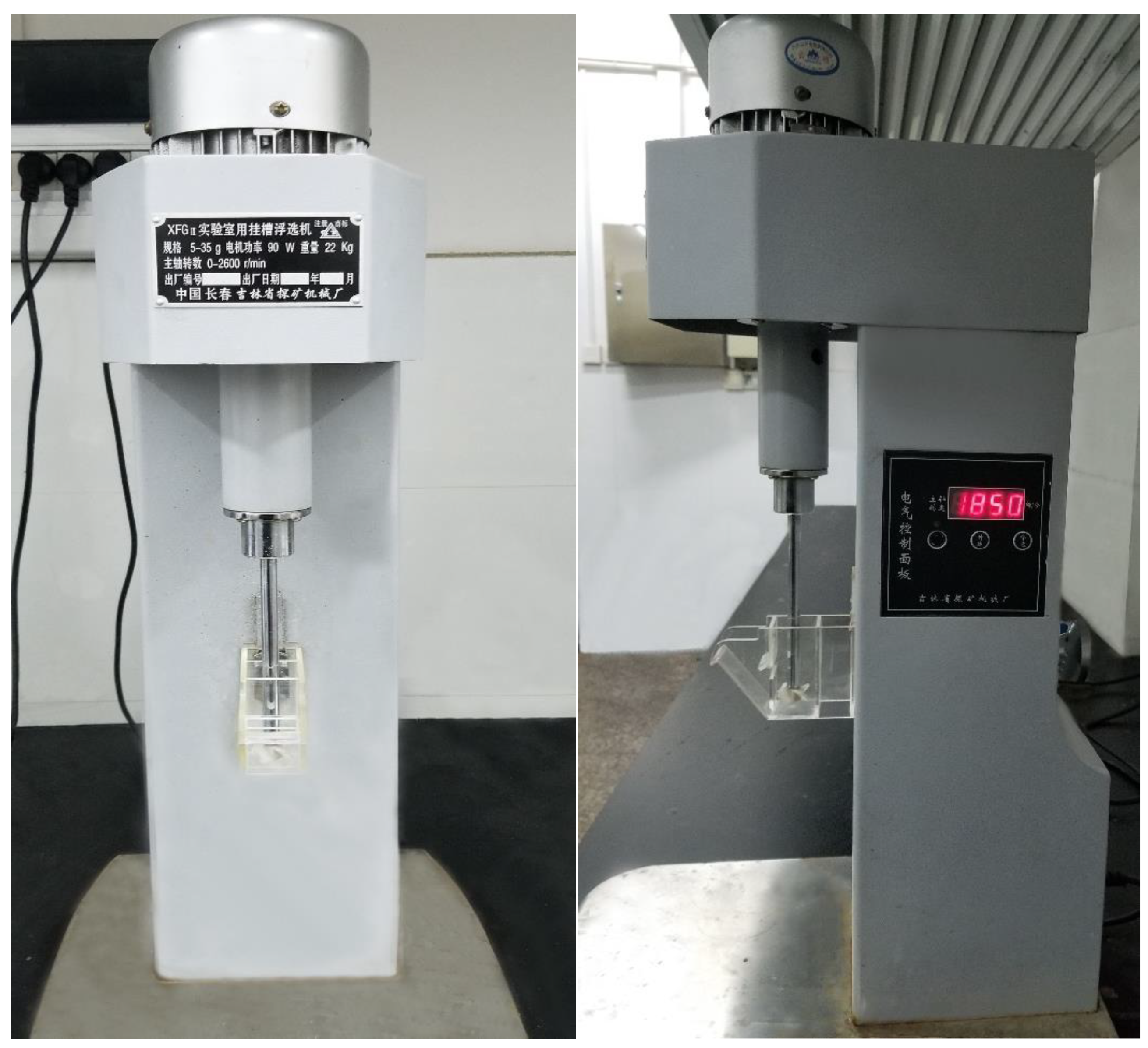
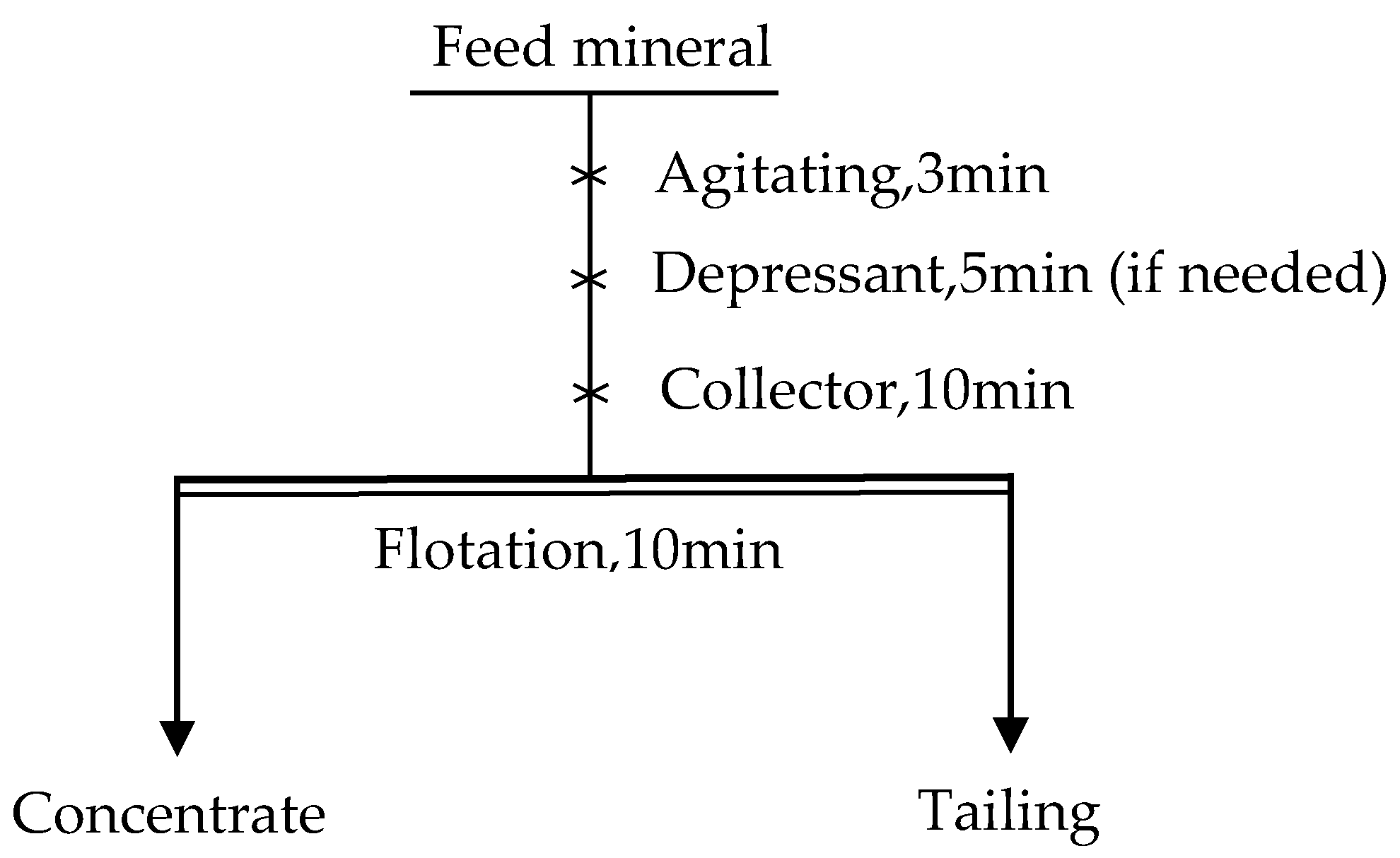

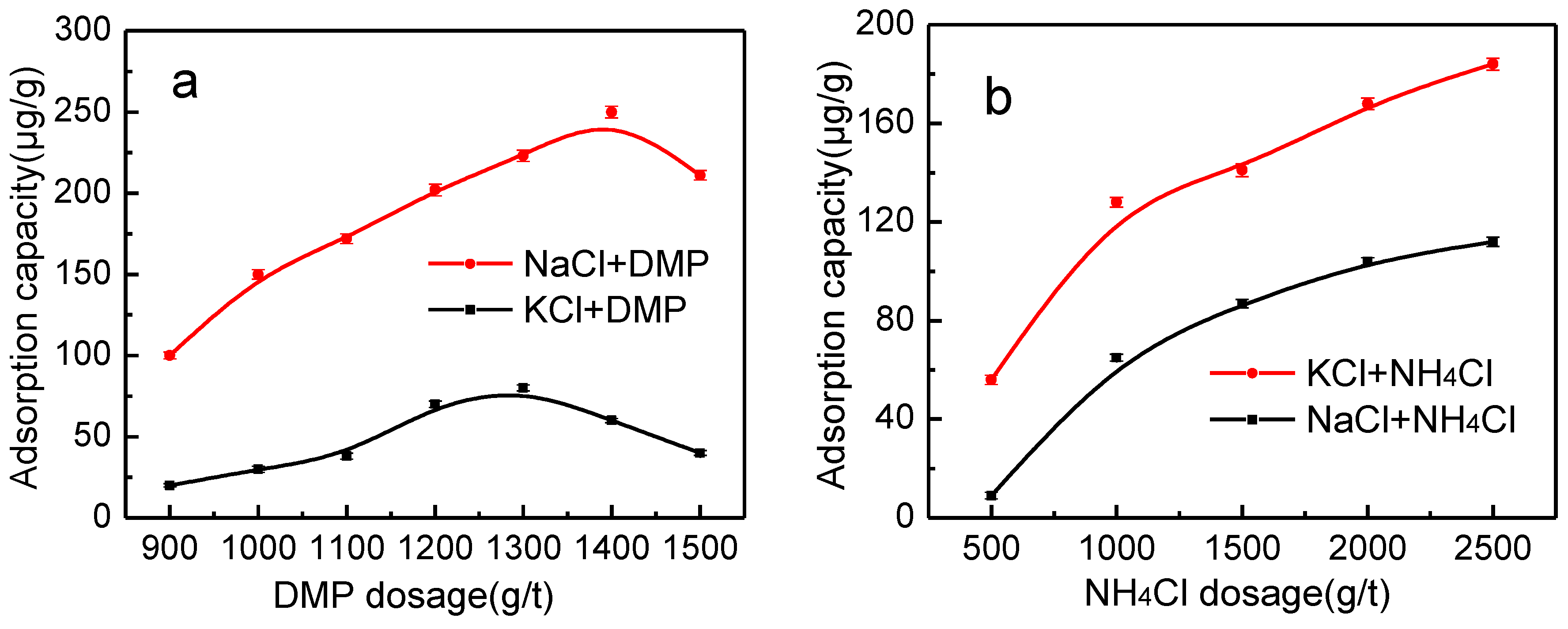
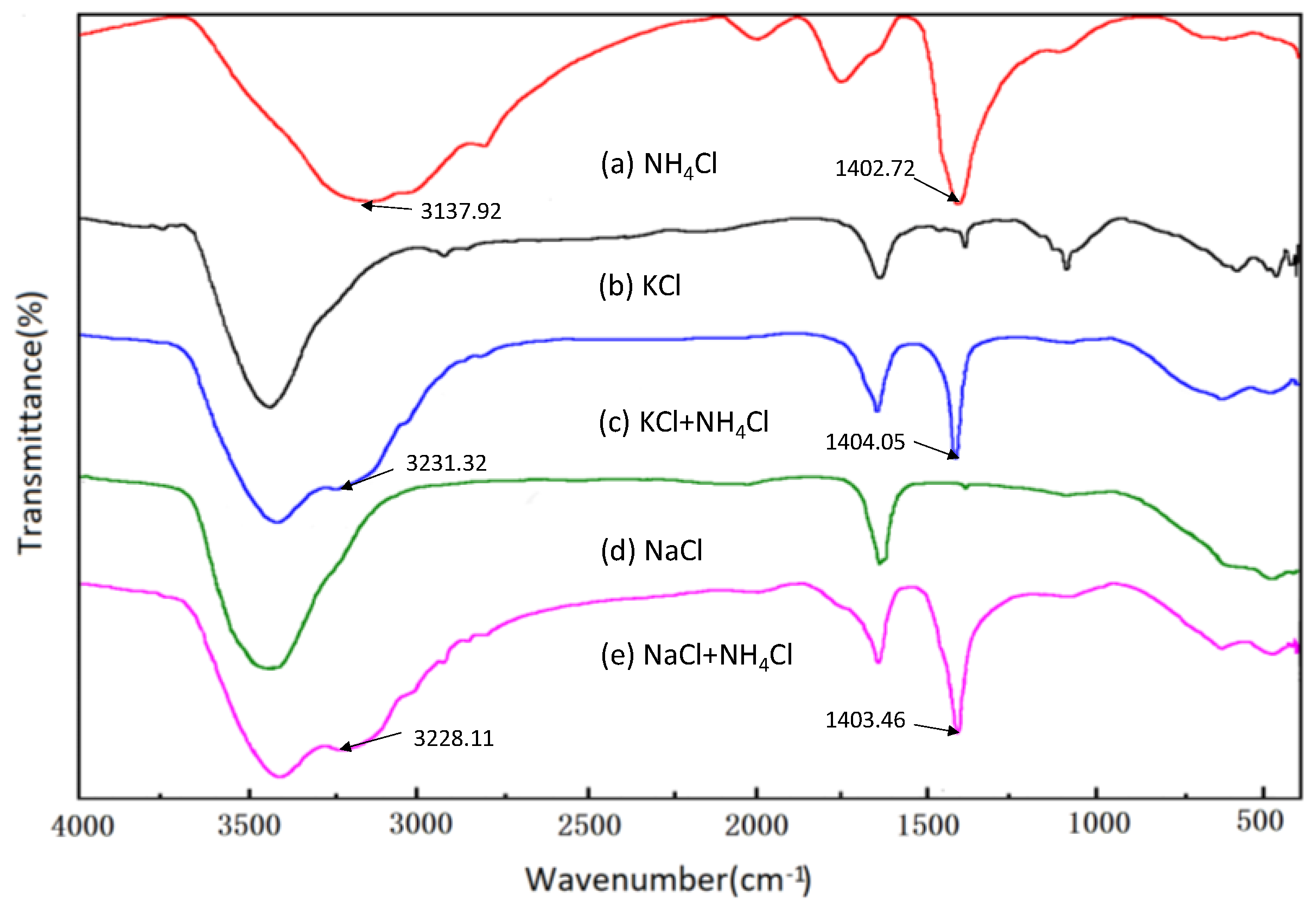
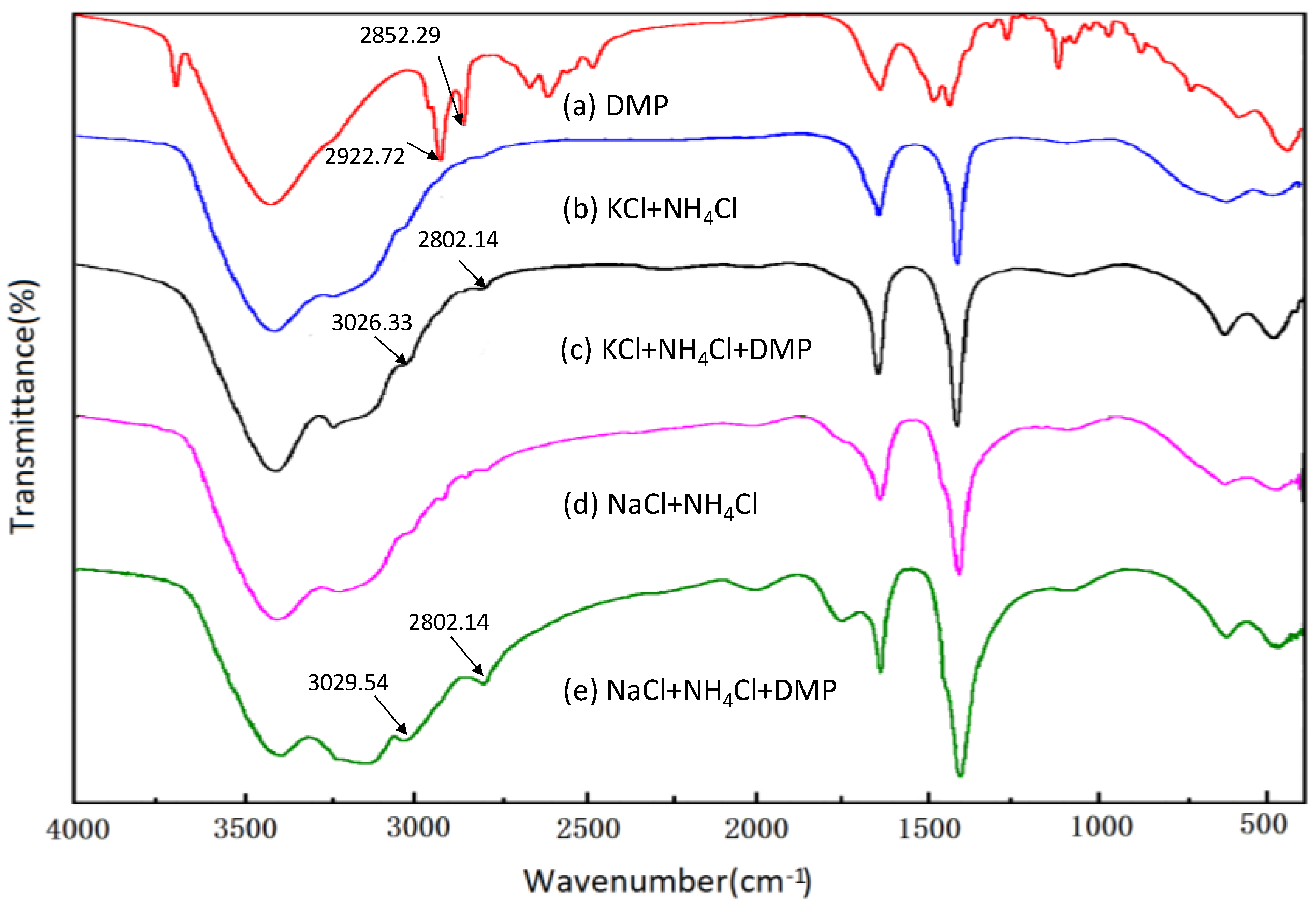
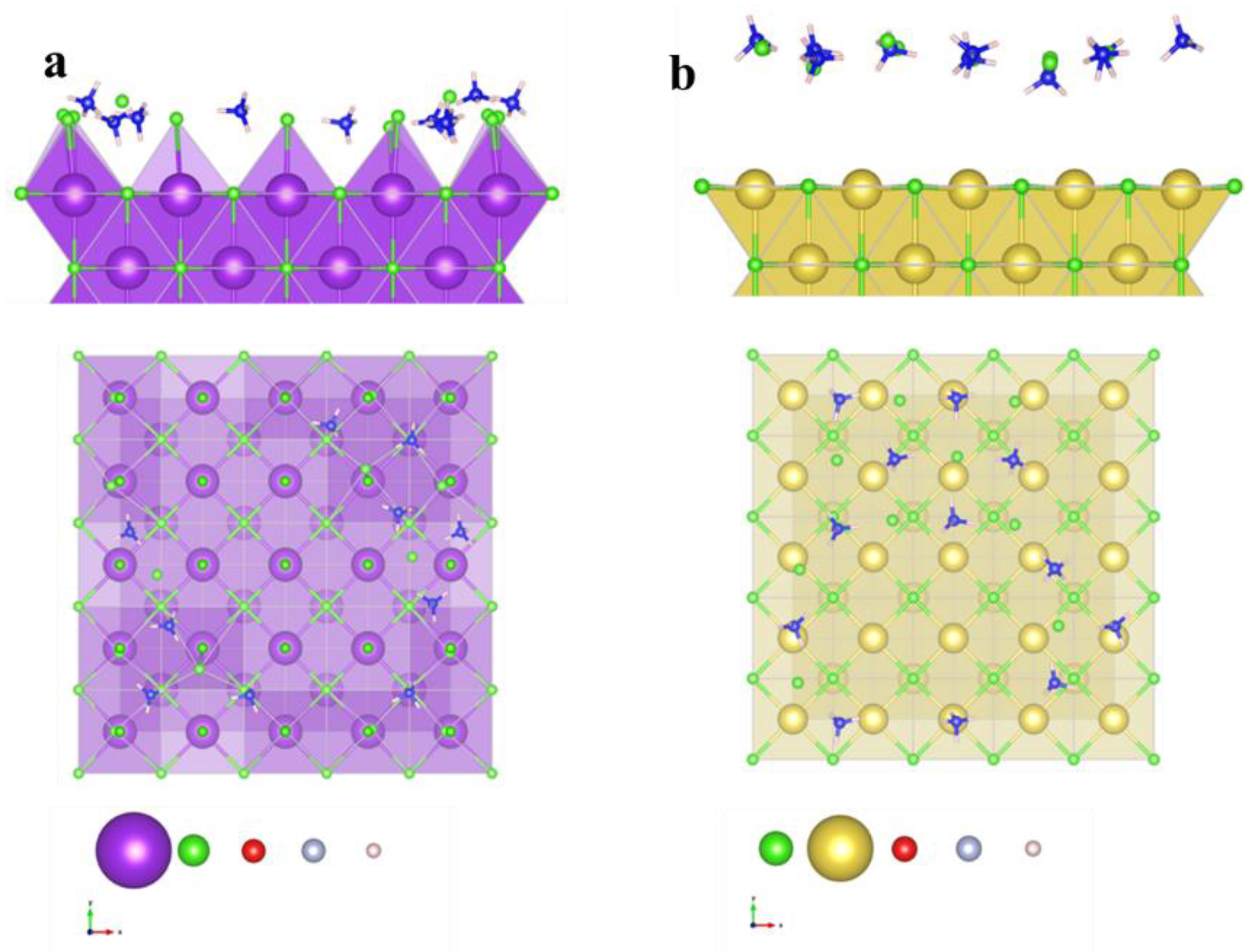
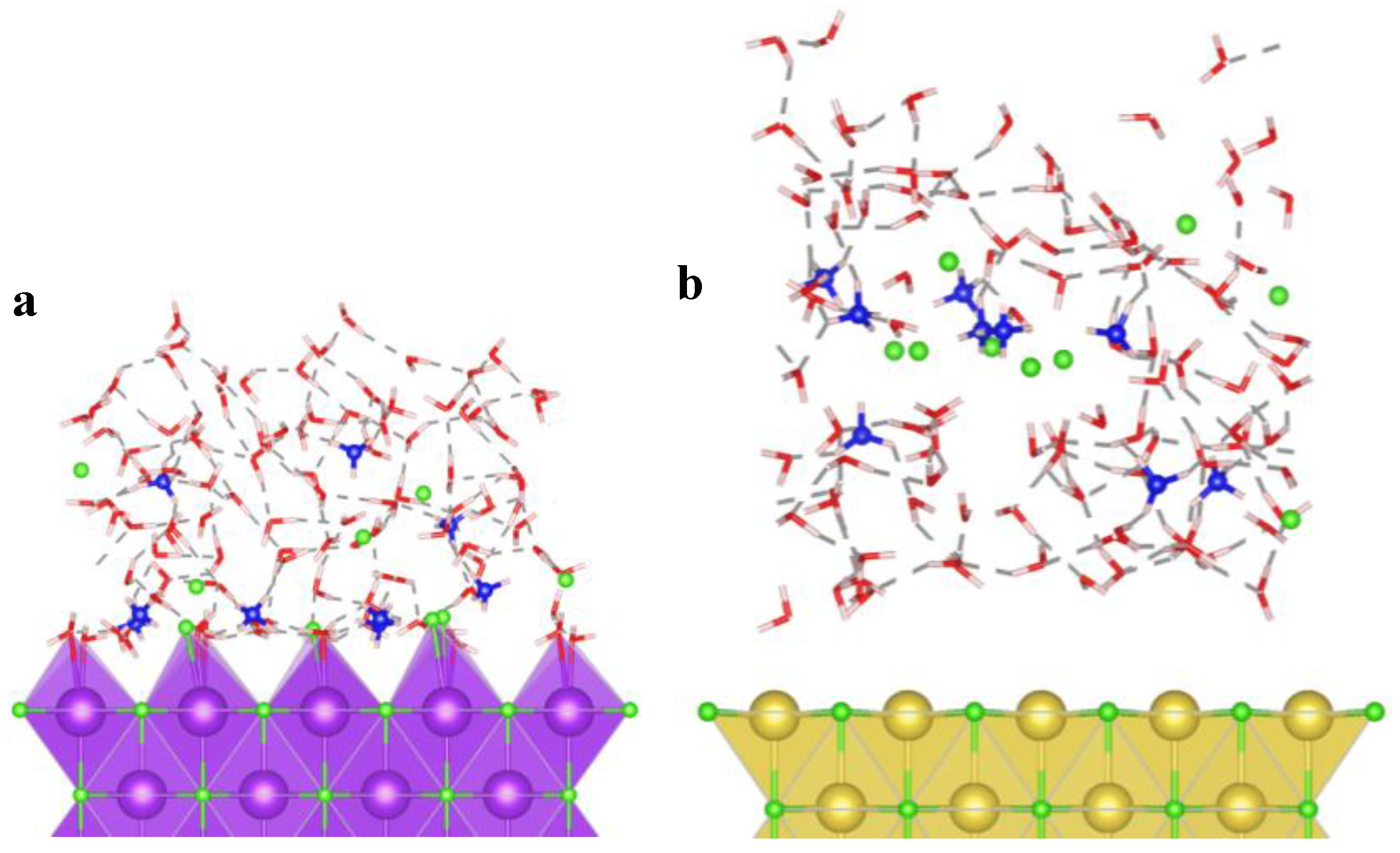
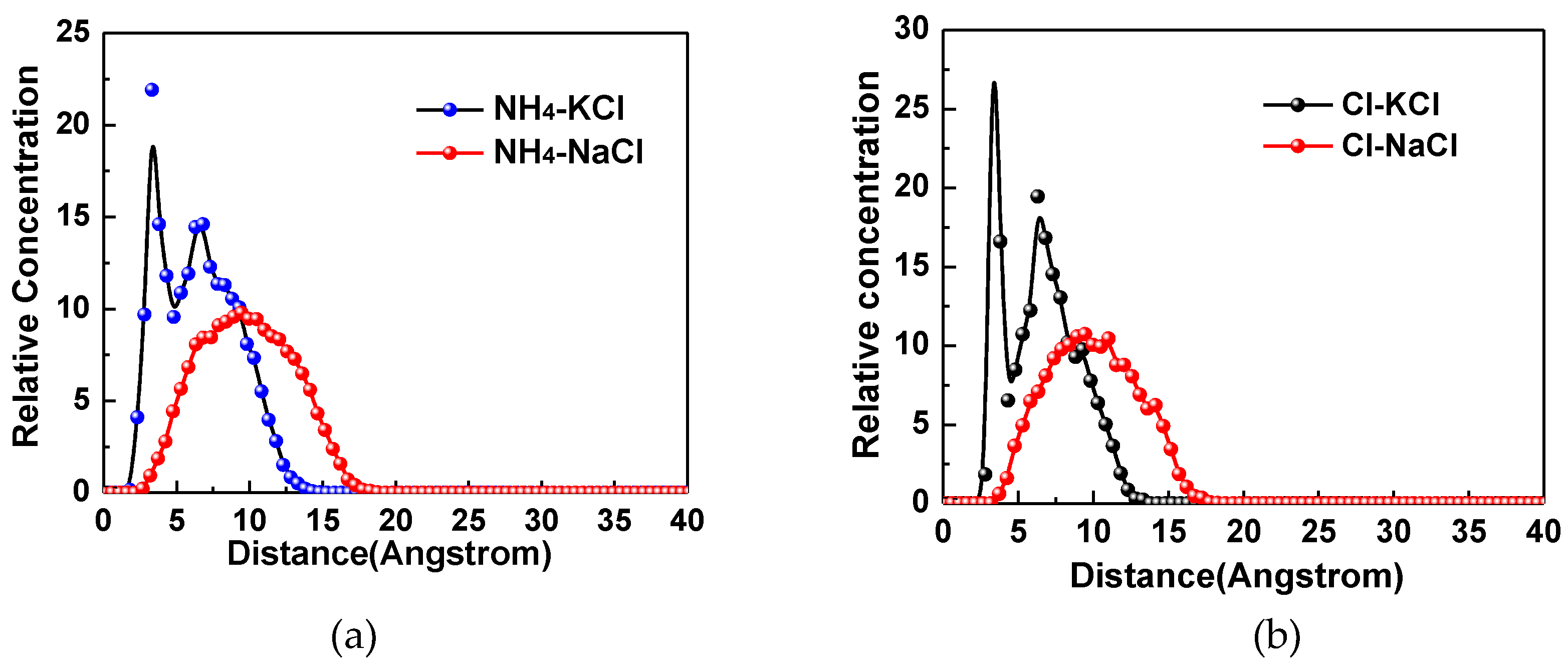
| Chemical | Concentration | Supplier | Role |
|---|---|---|---|
| KCl | 98% | Sinopharm Chemical Reagent Co., Ltd., Beijing, China | Pure minerals |
| NaCl | 99% | Sinopharm Chemical Reagent Co., Ltd., Beijing, China | Pure minerals |
| MgCl2·6H2O | 99% | Sinopharm Chemical Reagent Co., Ltd., Beijing, China | Preparation of saturated brine |
| CaSO4·2H2O | 99% | Sinopharm Chemical Reagent Co., Ltd., Beijing, China | Preparation of saturated brine |
| NH4Cl | 99% | Sinopharm Chemical Reagent Co., Ltd., Beijing, China | Regulator |
| DMP | - | In-house | Collector |
| Composition | MgCl2 | NaCl | KCl | CaSO4 | H2O |
|---|---|---|---|---|---|
| Content (%) | 33.60 | 0.55 | 0.37 | 0.14 | 65.34 |
© 2019 by the authors. Licensee MDPI, Basel, Switzerland. This article is an open access article distributed under the terms and conditions of the Creative Commons Attribution (CC BY) license (http://creativecommons.org/licenses/by/4.0/).
Share and Cite
Liu, R.; Lu, H.; Wang, L.; Tian, M.; Sun, W. Utilization of Ammonium Chloride as a Novel Selective Depressant in Reverse Flotation of Potassium Chloride. Minerals 2019, 9, 41. https://doi.org/10.3390/min9010041
Liu R, Lu H, Wang L, Tian M, Sun W. Utilization of Ammonium Chloride as a Novel Selective Depressant in Reverse Flotation of Potassium Chloride. Minerals. 2019; 9(1):41. https://doi.org/10.3390/min9010041
Chicago/Turabian StyleLiu, Runqing, Hongyu Lu, Li Wang, Mengjie Tian, and Wei Sun. 2019. "Utilization of Ammonium Chloride as a Novel Selective Depressant in Reverse Flotation of Potassium Chloride" Minerals 9, no. 1: 41. https://doi.org/10.3390/min9010041
APA StyleLiu, R., Lu, H., Wang, L., Tian, M., & Sun, W. (2019). Utilization of Ammonium Chloride as a Novel Selective Depressant in Reverse Flotation of Potassium Chloride. Minerals, 9(1), 41. https://doi.org/10.3390/min9010041







